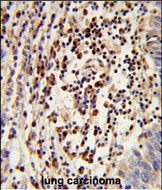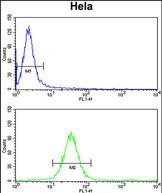MOSC2 Antibody (C-term)
Affinity Purified Rabbit Polyclonal Antibody (Pab)
- SPECIFICATION
- CITATIONS
- PROTOCOLS
- BACKGROUND

Application
| WB, FC, IHC-P, E |
|---|---|
| Primary Accession | Q969Z3 |
| Reactivity | Human |
| Host | Rabbit |
| Clonality | Polyclonal |
| Isotype | Rabbit IgG |
| Calculated MW | 38023 Da |
| Antigen Region | 270-300 aa |
| Gene ID | 54996 |
|---|---|
| Other Names | Mitochondrial amidoxime reducing component 2, mARC2, 1---, Molybdenum cofactor sulfurase C-terminal domain-containing protein 2, MOSC domain-containing protein 2, Moco sulfurase C-terminal domain-containing protein 2, MARC2, MOSC2 |
| Target/Specificity | This MOSC2 antibody is generated from rabbits immunized with a KLH conjugated synthetic peptide between 270-300 amino acids from the C-terminal region of human MOSC2. |
| Dilution | WB~~1:1000 FC~~1:10~50 IHC-P~~1:50~100 E~~Use at an assay dependent concentration. |
| Format | Purified polyclonal antibody supplied in PBS with 0.09% (W/V) sodium azide. This antibody is purified through a protein A column, followed by peptide affinity purification. |
| Storage | Maintain refrigerated at 2-8°C for up to 2 weeks. For long term storage store at -20°C in small aliquots to prevent freeze-thaw cycles. |
| Precautions | MOSC2 Antibody (C-term) is for research use only and not for use in diagnostic or therapeutic procedures. |
| Name | MTARC2 (HGNC:26064) |
|---|---|
| Synonyms | MARC2, MOSC2 |
| Function | Catalyzes the reduction of N-oxygenated molecules, acting as a counterpart of cytochrome P450 and flavin-containing monooxygenases in metabolic cycles (PubMed:21029045, PubMed:24423752). As a component of prodrug-converting system, reduces a multitude of N-hydroxylated prodrugs particularly amidoximes, leading to increased drug bioavailability (PubMed:21029045, PubMed:24423752). May be involved in mitochondrial N(omega)-hydroxy-L-arginine (NOHA) reduction, regulating endogenous nitric oxide levels and biosynthesis (PubMed:21029045). Postulated to cleave the N-OH bond of N-hydroxylated substrates in concert with electron transfer from NADH to cytochrome b5 reductase then to cytochrome b5, the ultimate electron donor that primes the active site for substrate reduction (PubMed:21029045). |
| Cellular Location | Mitochondrion outer membrane; Peripheral membrane protein. Peroxisome |

Thousands of laboratories across the world have published research that depended on the performance of antibodies from Abcepta to advance their research. Check out links to articles that cite our products in major peer-reviewed journals, organized by research category.
info@abcepta.com, and receive a free "I Love Antibodies" mug.
Provided below are standard protocols that you may find useful for product applications.
Background
Catalytic component of the benzamidoxime prodrug-converting complex, a complex required to reduce N-hydroxylated structures, such as benzamidoxime prodrug. Benzamidoxime is an amidine prodrug produced by N-hydroxylation which is used to enhance bioavailability and increase intestinal absorption. It is then reduced into benzamidine, its active amidine, by the benzamidoxime prodrug-converting complex.
References
Havemeyer,A., et.al., J. Biol. Chem. 281 (46), 34796-34802 (2006)
Simpson,J.C., et.al.,EMBO Rep. 1 (3), 287-292 (2000)
If you have used an Abcepta product and would like to share how it has performed, please click on the "Submit Review" button and provide the requested information. Our staff will examine and post your review and contact you if needed.
If you have any additional inquiries please email technical services at tech@abcepta.com.













 Foundational characteristics of cancer include proliferation, angiogenesis, migration, evasion of apoptosis, and cellular immortality. Find key markers for these cellular processes and antibodies to detect them.
Foundational characteristics of cancer include proliferation, angiogenesis, migration, evasion of apoptosis, and cellular immortality. Find key markers for these cellular processes and antibodies to detect them. The SUMOplot™ Analysis Program predicts and scores sumoylation sites in your protein. SUMOylation is a post-translational modification involved in various cellular processes, such as nuclear-cytosolic transport, transcriptional regulation, apoptosis, protein stability, response to stress, and progression through the cell cycle.
The SUMOplot™ Analysis Program predicts and scores sumoylation sites in your protein. SUMOylation is a post-translational modification involved in various cellular processes, such as nuclear-cytosolic transport, transcriptional regulation, apoptosis, protein stability, response to stress, and progression through the cell cycle. The Autophagy Receptor Motif Plotter predicts and scores autophagy receptor binding sites in your protein. Identifying proteins connected to this pathway is critical to understanding the role of autophagy in physiological as well as pathological processes such as development, differentiation, neurodegenerative diseases, stress, infection, and cancer.
The Autophagy Receptor Motif Plotter predicts and scores autophagy receptor binding sites in your protein. Identifying proteins connected to this pathway is critical to understanding the role of autophagy in physiological as well as pathological processes such as development, differentiation, neurodegenerative diseases, stress, infection, and cancer.





